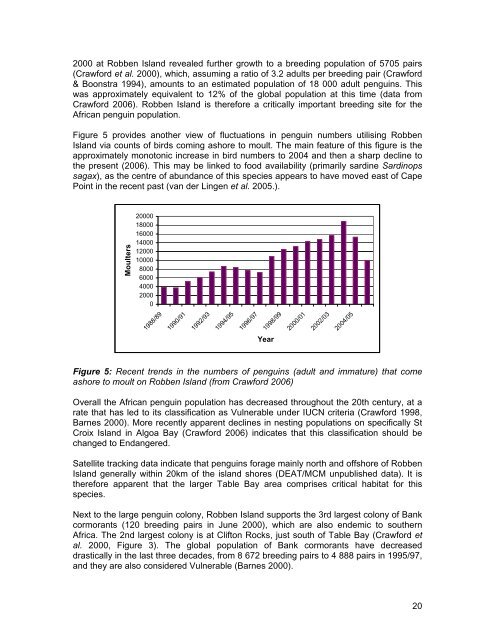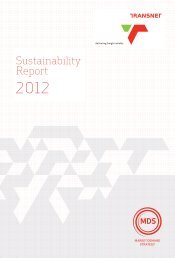BEN SCHOEMAN DOCK BERTH DEEPENING Specialist ... - Transnet
BEN SCHOEMAN DOCK BERTH DEEPENING Specialist ... - Transnet
BEN SCHOEMAN DOCK BERTH DEEPENING Specialist ... - Transnet
You also want an ePaper? Increase the reach of your titles
YUMPU automatically turns print PDFs into web optimized ePapers that Google loves.
2000 at Robben Island revealed further growth to a breeding population of 5705 pairs<br />
(Crawford et al. 2000), which, assuming a ratio of 3.2 adults per breeding pair (Crawford<br />
& Boonstra 1994), amounts to an estimated population of 18 000 adult penguins. This<br />
was approximately equivalent to 12% of the global population at this time (data from<br />
Crawford 2006). Robben Island is therefore a critically important breeding site for the<br />
African penguin population.<br />
Figure 5 provides another view of fluctuations in penguin numbers utilising Robben<br />
Island via counts of birds coming ashore to moult. The main feature of this figure is the<br />
approximately monotonic increase in bird numbers to 2004 and then a sharp decline to<br />
the present (2006). This may be linked to food availability (primarily sardine Sardinops<br />
sagax), as the centre of abundance of this species appears to have moved east of Cape<br />
Point in the recent past (van der Lingen et al. 2005.).<br />
Moulters<br />
20000<br />
18000<br />
16000<br />
14000<br />
12000<br />
10000<br />
8000<br />
6000<br />
4000<br />
2000<br />
0<br />
1988/89<br />
1990/91<br />
1992/93<br />
1994/95<br />
1996/97<br />
1998/99<br />
2000/01<br />
2002/03<br />
2004/05<br />
Year<br />
Figure 5: Recent trends in the numbers of penguins (adult and immature) that come<br />
ashore to moult on Robben Island (from Crawford 2006)<br />
Overall the African penguin population has decreased throughout the 20th century, at a<br />
rate that has led to its classification as Vulnerable under IUCN criteria (Crawford 1998,<br />
Barnes 2000). More recently apparent declines in nesting populations on specifically St<br />
Croix Island in Algoa Bay (Crawford 2006) indicates that this classification should be<br />
changed to Endangered.<br />
Satellite tracking data indicate that penguins forage mainly north and offshore of Robben<br />
Island generally within 20km of the island shores (DEAT/MCM unpublished data). It is<br />
therefore apparent that the larger Table Bay area comprises critical habitat for this<br />
species.<br />
Next to the large penguin colony, Robben Island supports the 3rd largest colony of Bank<br />
cormorants (120 breeding pairs in June 2000), which are also endemic to southern<br />
Africa. The 2nd largest colony is at Clifton Rocks, just south of Table Bay (Crawford et<br />
al. 2000, Figure 3). The global population of Bank cormorants have decreased<br />
drastically in the last three decades, from 8 672 breeding pairs to 4 888 pairs in 1995/97,<br />
and they are also considered Vulnerable (Barnes 2000).<br />
20

















